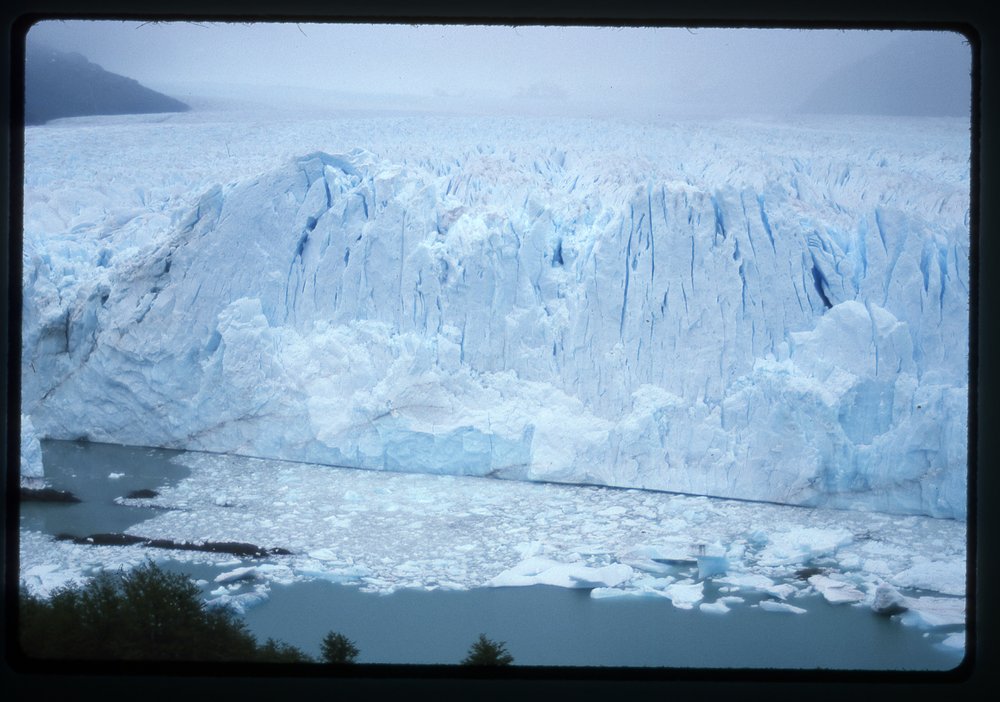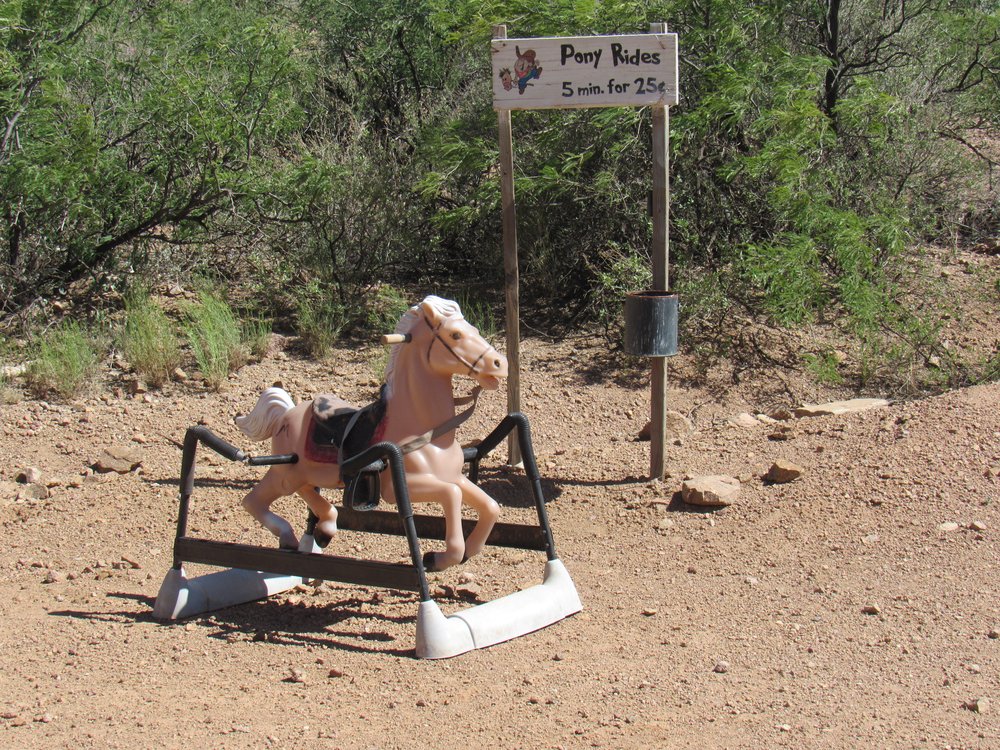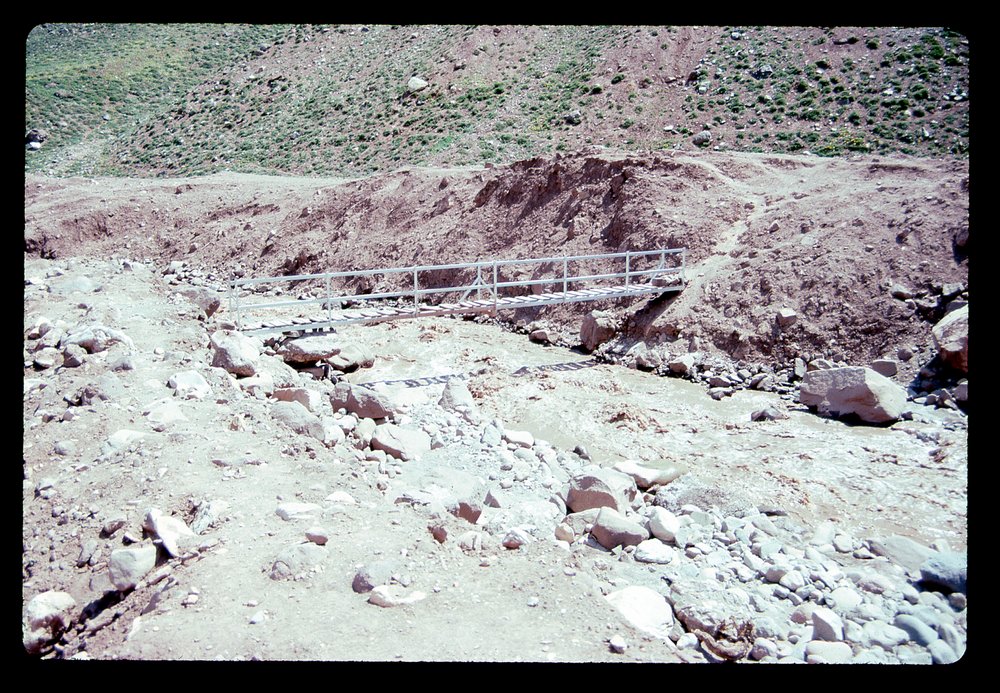Perito Moreno
If you’re ever in the province of Santa Cruz in Argentina, I recommend you pay a visit to the Perito Moreno glacier. It’s easy to get to – a nice paved road gets you there. You park, and a short walk takes you to a view point where you will see something not easily seen anywhere else in the world. The snout of the glacier towers 250 feet above Lago Argentino – this is where the glacier ends after its 19-mile journey from the heart of the Southern Patagonian Ice Field, which is the world’s third-largest reserve of fresh water. I took this picture when I visited in January of 1991.
Well-trodden paths lead down to the water’s edge at the lake shore. There, signs in several languages warn you to stay away, as massive chunks of ice can break away from the front of the glacier at any time and fall into the lake, causing huge waves to shoot across the narrow gap and sweep up onto the shore. People have been swept to their deaths in the icy waters. Nevertheless, you don’t have to watch very long to see pieces of ice break off and fall hundreds of feet into the water – it’s an amazing sight, and people come from all over the world to see the spectacle. Every few years, the glacier advances right up to the land and blocks the lake from draining naturally. It’s worth reading what happens here.
One more thing I wanted to mention, and I’ve spoken at length about this before on my Desert Mountaineer site, is how the southern hemisphere can be so much colder than the northern hemisphere at comparable latitudes. The Perito Moreno glacier is found at the same latitude as Brussels, Belgium is in the north – amazing, huh?
Exit Visa
I’ve never understood the logic of an exit visa. Why should you have to go through any kind of an inspection to leave a country? I would think they’d be glad to be rid of you. Now, entering a country, that’s another story. One time, a busload of us spent hours being grilled and inspected by Chilean customs officials at a remote border crossing as we tried to leave Chile so we could then enter Argentina. Those two countries have had a bizarre love-hate relationship which has lasted forever, but that day, those Chileans acted like a bunch of pompous assholes as they lorded their authority over our group of international travelers. They spent several hours prolonging a process that could have been easily done in 30 minutes. As a result, when we cleared Argentine customs, a fairly quick and pleasant next step, so much time had passed that the buses we had hoped to catch had already left the nearby Argentine city. None were available until the next day.
My flight left the next morning from a city quite a distance away – that bus, long-gone, was to have gotten me there in plenty of time. Now what? I walked to the edge of town and stuck out my thumb to try and hitch a ride. What to my wondering eyes should appear but a VW mini-van full of hippies, or at least what would pass for hippies in 1991 Argentina. The 5 of them, 3 men and 2 women, had driven the thousand miles from Buenos Aires practically non-stop and were about as bleary-eyed as could be expected. It was getting dark, and they asked me if I would be willing to drive. Gladly! It was a wild ride through mountainous country, fairly slow going, and hours later we arrived at our destination safe and sound. I got out in the middle of the city and found lodging for the night. The next morning, to thank me for helping with the driving, they picked me up and gave me a ride to the airport. It was a happy ending for us all.
Easter Bunny
What ever possessed my father to bring home a tiny bunny one easter, I’ll never know. I guess he thought it was cute, but the poor creature was soon relegated to a makeshift pen and a life of solitude in the gloomy basement. This was around 1960, back in the days when deliverymen still brought a lot of things to your home. The milkman, the bakery guy, the Fuller brush man and a guy who brought fresh fruit and vegetables. This last guy was someone my mother bought from each week, and now that we had a rabbit, he would give us his wilted stuff that was unfit to sell.
It didn’t take long before that tiny bunny got really big, and there was no way we could keep it. My Aunt Susie and her family lived in a small town a hundred miles away, and their friend had a farm and would gladly take the rabbit. It was a good excuse to visit. Perhaps the rabbit ended up in a stew pot, we never knew, but it seemed like a good solution to our problem, hopefully for the rabbit too.
Pony Rides
Andy and I had put in a fairly strenuous day climbing a couple of peaks. We had started the long drive home when we came across this roadside attraction. It sat beside a well-traveled dirt road about a mile from the Mexican border. You couldn’t miss it, really. I didn’t have a quarter on me, otherwise I would have liked to have stopped for a ride.
Lousy Driving
Back in the 80s, I was by myself on a peakbagging jag in the back-country of Arizona. I had been out for a week and had racked up a nice bunch of peaks in the process. One afternoon when I was particularly far away from humanity, maybe 40 miles from any help, I was backing up along a road to position my truck in a better place to park for a peak. For some reason, I just assumed that the road was without any obstacles or issues behind me, so I continued to back up slowly. All of a sudden, with a mighty thump, my right rear wheel dropped down. I shut off the engine and put on the emergency brake, then got out and walked around to the back.
God help us! The edge of the road had eroded clean away from water runoff in the past, leaving a deep hole. My wheel was sitting in thin air, the rear axle sitting on the dirt of the edge of the road. My truck didn’t have anything special like positraction or any of those fancy things that some vehicles have. All I could do was lock the front hubs and put it into four-wheel-drive. Fortunately for me, it looked like there had been some signs of habitation there at one time. I found a bunch of old boards nearby and hauled them over to my truck. There were plenty of them, and I managed to work enough of them down into the hole and under my wheel that there was something for it to grip. Eventually, after a few tries, I escaped from the pit, and you can bet that I paid a lot better attention when backing up after that.
Fording The River
They had told me ahead of time that I would have to ford the Río Horcones. It wouldn’t be particularly deep, about mid-thigh, but I should expect it to be mighty cold, as it was glacier-fed. While still in town, I had bought a pair of the cheapest sneakers I could find, something just for that purpose and something I could also wear while knocking around camp. That way, I wouldn’t have to wear my climbing boots for the ford and get them soaked, as they’d take forever to dry out. Fording something with an unknown bottom in bare feet can be dangerous, as it’s a good way to lose your footing in swift water. The shoes served me well, and I had them ready several weeks later on the way back out. Imagine my surprise when I saw this, a sturdy metal footbridge that had been placed in my absence. A big improvement, for sure.
Bathing Beauty
Bariloche is a very popular place – tourists flock there in the summer to enjoy its lakes and mountains, and it also happens to be the most popular ski area in the southern hemisphere. I was there one summer and decided to backpack through a series of trails, much of the terrain above tree-line. I had already spent my first night camped by an alpine lake and had moved higher the next morning. Imagine my surprise when I rounded a corner and met a young woman who was sunbathing nude on a blanket by the shore of another another alpine lake, Laguna Schmoll. She didn’t seem embarrassed at all by my presence and struck up a friendly conversation, telling me about her life and work in Buenos Aires. If anything, it was I who was caught off guard and tried not to stare at her nakedness. I had many miles to cover before my next sleep so had to take my leave, but it took a while to get that image out of my head.
Lucky Ride
Patagonia is a vast, empty land. One morning I found myself at a junction, where there was nothing more than a cafe where a couple of lonely roads intersected. I had a ticket for a bus that would arrive in 8 hours and carry me away, but the thought of waiting that long made me crazy. As I sat inside nursing a cup of tea to stay out of the cold wind blowing outside, the thought occurred to me that maybe I could beg a ride from somebody passing through and heading my way. Maybe half an hour passed, and a nice new mid-sized Mercedes truck pulled up and the driver came in. I boldly introduced myself and asked the driver if he were headed west. He said yes, and I asked him if I could accompany him and buy him breakfast. The answer was yes on both accounts, and we settled in for a hot meal.
Before we left, at about 10:30, I gave my bus ticket away to another traveler who was hanging about the premises. Daniel and I drove for 5 hours on that gravel road, an actual highway with its own number, without seeing one single other vehicle, not one, until we finally came near a town much later in the day. Talk about wide, open spaces!
River Boat
Early that morning, the chopper had flown me and my partner the 50 miles from our base camp to a mountaintop and dropped us off for a day of prospecting. The nice thing about this day was that we didn’t have to cover much distance, just explore the high country in that area and get picked up late in the afternoon in the same spot. We were at about 5,200 feet, which put us well above tree-line that far north. Once the drone of the helicopter’s engine had faded away, we took stock of our surroundings.
To our east sat a huge icefield 25 miles across, spawning glaciers in every direction like a huge octopus. To the northwest and only 18 miles away sat Kates Needle, in plain view at just over 10,000 feet and one of the boundary peaks between BC and Alaska. A bit farther and in the same direction could be seen Devil’s Thumb. Its unclimbed 6,700-foot northwest face, the highest in North America and a true killer, made this peak a legend. It gave you chills just looking at it.
Only 3 miles to the west was the Stikine River, at that point only 65 feet above sea level, and flowing into it was something called the Great Glacier. We could also see the Flood Glacier and the Mud Glacier, both a little farther upstream, both of which came right down to the level of the river. As we sat there and contemplated all of this, to say that we were gobsmacked would be an understatement. Even more amazing was that they were paying us for doing this.
Now I come to the punch line. When you’re in a place of such wilderness, even the tiniest sound that is out of the ordinary stands out clearly. We thought we heard an engine of some kind, very faint or far away. Was it a plane or a helicopter? No, it didn’t exactly seem like either one. It didn’t fade away, but persisted. It seemed to be coming from down below, from the direction of the river. Was that a boat? We had binoculars, and as we looked below we were surprised to see what looked like an old-fashioned river boat heading upstream. We followed it for a while, wondering what it was and where it was going. There it was, more than 5,000 feet below us. What an adventure that would have been, that July day in 1967, to have been a passenger on that boat, slowly heading up that historic river! Only later did we learn the actual story. A man named Ed Callbreath, who had been born in Telegraph Creek, BC in 1930, but lived most of his life in Wrangell, Alaska, decided to have a boat built that was suitable for river travel. He named it the Margaret Rose. For 3 summers, in 1966, 1967 and 1968, from May to October, he made the 175-mile run from Wrangell to Telegraph Creek. Because of the swift current, it took 3 days to make the trip upstream and only half a day for the return. At night, they would pull over and tie the boat up. They had cabins for as many as 30 passengers and charged $129.50 for the round-trip. He said the Stikine was the most scenic navigable river in all of Alaska.



